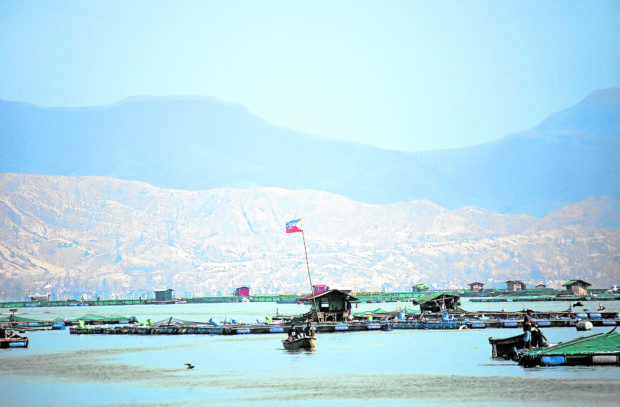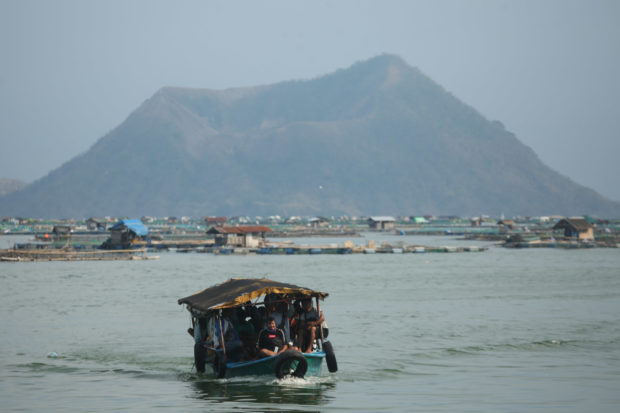Phivolcs belies Taal Volcano has erupted

QUIET FOR NOW Fishermen pass by a fish pen in Taal Lake where a Philippine flag has been placed. Behind them is Taal Volcano. Locals said plumes emitted by the volcano are sometimes seen in the morning but no other visible increased activity on Monday. —LYN RILLON
Taal Volcano has not erupted even as it spewed kilometer-high plumes from its main crater on Monday and remained under increased unrest, the Philippine Institute of Volcanology and Seismology (Phivolcs) said.
Phivolcs, in a separate post on its Facebook page on Sunday night, also uploaded a minutelong video footage of the volcano’s crater to prove that no eruption was happening, contrary to claims circulating in social media platforms that have caused panic among residents in towns surrounding the volcano.
“Footage of Taal Main Crater taken from the station VTMC between 7:30 and 8:30 this evening. Contrary to claims being circulated by some social media posts, no eruptive activity has occurred,” the caption said.
Irresponsible
The head of the local Disaster Risk Reduction and Management Office (DRRMO) of Talisay town in Batangas province, which faces Taal Lake, assailed netizens over false reports that the volcano erupted on Sunday night.
“Some irresponsible social media users have caused public panic when they falsely reported that the volcano was erupting,” Peter John Mirania, chief of Talisay DRRMO, said in a phone interview on Monday.
Article continues after this advertisementMirania said some netizens were reporting via Facebook Live past 7 p.m. on Sunday of the supposed Taal eruption.
Article continues after this advertisementSeveral videos posted online on Sunday evening showing streaks of what appeared to be lightning above Pulo, the volcano island in the middle of Taal Lake, causing netizens to believe the volcano was erupting.
Mirania said he immediately posted an update on social media to explain that the streak of light was only caused by a thunderstorm.
Phivolcs, in its Sunday night advisory, also said the lightning was from a localized thunderstorm in Laurel town in Batangas.
“In times like these, social media should only be used to advance and spread truthful information for the benefit of the public,” stressed Mirania.
Hot fluids
In its bulletin on Monday morning, Phivolcs said hot volcanic fluids in the main crater lake caused the plumes, which reached a kilometer high before drifting toward the west-northwest direction.
The Taal Volcano network did not detect any earthquakes between Sunday morning and Monday morning, but state volcanologists noted the persistence of a low-level background tremor since early April.

CONSTANT THREAT A boat carrying caretakers of fish cages makes its way to the shoreline of Talisay, Batangas, on Monday. Workers in the aquaculture industry in Taal Lake and villagers in lakeshore communities live with the constant threat of displacement from the active Taal Volcano, which last erupted in January 2020. —LYN RILLON
High temperatures, sulfur dioxide emissions and the steady expansion and inflation of the Taal region all pointed to persistent magmatic activity at shallow depths beneath the volcano, Phivolcs said.
With alert level 2 still raised over Taal, state volcanologists recommend the strict prohibition on entry into the Taal Volcano Island, locally known as Pulo, and within the volcano’s permanent danger zone, especially in the vicinity of the main crater and the Daang Kastila fissure, or Taal’s northern flank. They also recommend against occupancy and boating on Taal Lake.
Phivolcs raised the alert status of Taal, the country’s second most active volcano, to level 2 in March, after observing an increase in volcanic quakes, changes in the temperature in the main crater lake and continuous ground deformation.
Taal erupted in January 2020, more than four decades after its previous eruption, sending hundreds of thousands fleeing from within the volcano’s 14-kilometer radius.
Register first
In February this year, some Talisay residents who owned or watched over fish cages in Taal Lake were evacuated by Coast Guard personnel and policemen from their makeshift huts on Pulo after the volcano registered a series of earthquakes. These residents stayed on the island during daytime to attend to their fish cages.
According to Mirania, they still have more than 400 evacuees from last year’s eruption that are sheltered in three evacuation centers in the town.
The government has declared Pulo a permanent danger zone and barred the return of residents who had lived off farming, fishing and tourism on Pulo.
A police desk was set up on Talisay’s lakeshore to serve as a registration station for those who wanted to go to Pulo to feed their fish stock. INQ